|
Advantech TREK-520
A compact, rugged in-vehicle computing/display system for fleet management and mobile resource management applications
(by Conrad H. Blickenstorfer, photography by Carol Cotton)
The Advantech TREK-520 is a computer designed specifically with the needs of local fleet management in mind, the kind of fleets of small trucks that make local deliveries, government fleets that operate locally, as well as taxi cabs and delivery services. The TREK-520, which Advantech calls a mobile data terminal, can operate in the harshest environments, works in an extreme temperature range of -22 to 158 degrees Fahrenheit, and easily survives almost any degree of shock and vibration. It can handle car power (which isn't always "clean" or stable), and with its suspend/wakeup function, the TREK-520 fits into 24/7 monitoring systems with its digital input and WWAN wakeup features.
As the mobile component of automated fleet management and mobile resource management systems, the TREK-520 facilitates real time tracking, dispatching, increasing driver safety and asset utilization, while reducing errors, unauthorized vehicle use, fuel usage and overall costs. The picture below shows the pieces of a TREK-520-based mobile resource management system, with the TREK-520 unit and its antennae on the right, and a vehicle monitor (for illustration purposes an Advantech TREK-303H) on the left.

Modern fleet management is made possible by a combination of rugged, compact computing equipment that can handle the specific types of punishment of vehicle use; integration with GPS functionality that enables location-based services; and increasing integration of computers into the vehicle itself. Here's how it all works:
- A small, rugged computer system unit can be mounted anywhere in the vehicle, usually in a place where it doesn't get in the way. The system unit is then connected to a compact vehicle display that can be operated both via touch and also with programmable function keys.
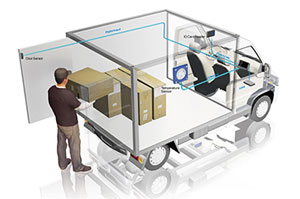 - The system unit may communicate via standard COM ports with such legacy peripherals as printers or barcode readers. It may also communicate with the vehicle directly through a CAN-bus (CAN stands for Controller Area Network and is a vehicle bus standard that lets various systems and devices communicate with one another). That way, the computer can access door locks, temperature controls, alarms, diagnostics, etc.
- The computer can also access numerous sensors throughout the vehicle, checking variables such as temperatures, pressures, acceleration, direction, etc. Depending on the application, all of this information can be processed and used for fleet management and mobile resource management purposes.
- Now add GPS and advanced data communication technology, and you have all the components for very sophisticated management systems that move data and information back and forth between vehicles and their dispatch or home base. The opportunities are almost endless.
This is what Advantech had in mind when they introduced the TREK-520 in-vehicle computer as part of the company's extensive fleet management systems product lineup.
The Advantech TREK-520 In-Vehicle Computer
If the TREK-520 looks a lot like one of Advantech's industrial PCs, it's because in most respects that is what it is. Many of the environmental requirements that apply to an industrial PC are similar or the same as those that apply to a vehicle computer. It must be as compact as possible for easy placement. It must be rugged enough to withstand abuse. It must be reliable enough to operate 24/7/365 with minimal maintenance and maximum up-time. It must provide suitable performance, generate a minimum of heat and noise, and support the standards and connectivity required for the task.
"Suitable" performance means as much as is required for the prospective jobs, no more and no less. With the TREK-520, Advantech resorted to a couple of tried-and-true RISC processors from Texas Instruments. The AM3703 and AM3715 ( see TI's product page) are part of TI's Sitara line of Cortex-A8 ARM processors that are compatible with the OMAP 3 architecture, have exceptionally low power consumption, and are available in extended temperature versions. The primary difference between the two is that the AM3715 has an integrated POWERVR SGX Graphics Accelerator for applications that require it. The chips support Windows Embedded CE and Linux, both of which are available from Advantech with the TREK-520. Why Windows CE and not full Windows? Because the size and complexity (and cost) of full Windows simply are not needed for the job.
Below you can see the TREK-520 from all four sides, as well as from the top, with the metal cover removed.
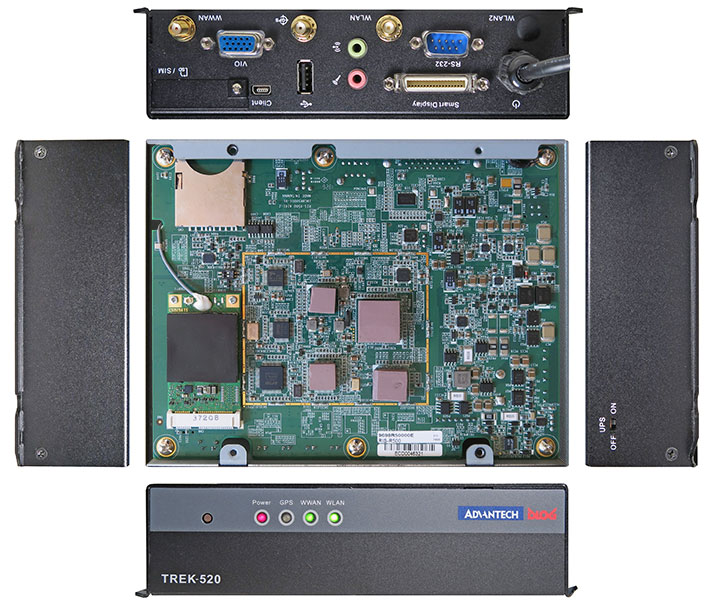
As is evident in the above image, the TREK-520, which measures just 6.8 x 5.3 x 1.73 inches inches and weighs just two pounds, is a very compact unit. Its strong, industrial-grade steel housing consists of two U-shaped halves. The lower half serves as the unit's chassis, with electronics and ports mounted onto it. The top half serves as the cover. The exterior of both halves is painted matte-black. 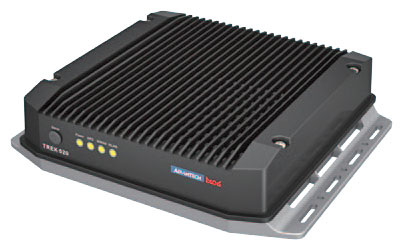 Note the blocks of thermally conductive material sitting on top of several of the chips. These make contact with the housing cover which serves as a cooling sink. Note the blocks of thermally conductive material sitting on top of several of the chips. These make contact with the housing cover which serves as a cooling sink.
What's not shown is the TREK-520 finned IP Protection Box (see picture to the right) that not only provides additional cooling, but also adds IP54 sealing, where the "5" means the unit is protected against dust, and the "4" that it can also handle water spray from all directions.
For access to the interior of the unit, remove eight small Philips head screws. The inside is neat and clean and well designed, as we'd come to expect from Advantech. The motherboard measures 170 x 130 mm, with some of its external ports mounted directly onto the board, and others connected via wires. Note that the TREK-520 has two SD Card slots. One of them (visible in the picture above) is externally accessible, the other is internal and holds the unit's OS that in our evaluation sample was on a 4GB industrial grade Advantech SQ Flash card. The unit's SIM card slot for GSM-based data communications is externally accessible (but protected by a screw-down cover) as well.
For I/O, the TREK-520 offers ample onboard connectivity for just about any task.
On the back side are:
- Audio Mic in
- Audio Stereo Line out
- 1 x DB9 RS232 serial port with optional 12V/1A on pin 9
- 1 x USB 2.0 Type B
- 1 x mini-B USB client
- 1 x VIO (Vehicle I/O, provides CAN Bus, J1708, isolated DI and DO)
- 1 x Smart Display port (provides power, LVDS, audio, UART, USB, power & reset signals)
- 1 x GPS antenna port
- 1 x WLAN antenna port
- 1 x WWAN antenna port
On the front, the TREK-520 has no ports, but:
- LED indicator for power status
- LED indicator for GPS status/activity
- LED indicator for WWAN status/activity
- LED indicator for WLAN status/activity
Note that the TREK-520 is designed to work one of Advantech's In-Vehicle Smart Display's specifically designed for the task. Connection is via a Smart Display cable that carries not just video, but also power, audio, UART, USB, as well as the power and reset signals.
The Advantech TREK-303H Smart Display
Advantech has been using a special, optimized design for in-vehicle displays and computers for a while now. The same basic form factor used in the TREK-303H is also used in the TREK-743, which is actually both a display and a computer. The TREK-303H, however, is meant to be used as part of a vehicle display system that also includes one of Advantech's suitable in-vehicle industrial computers, in this case the TREK-520.
As is, the TREK-303H touch panel, which measures 8.25 x 5.7 inches and is 1.3 inches thick, is compact enough for tight spaces, yet the 7-inch display is large enough to be useful and easy to use in all sorts of fleet management and dispatch applications. It also has a tough but fairly light housing that is compatible with RAM mounting solutions so that customers can easily install it according to their requirements.
Below you can see the Advantech TREK-303H Smart Display from the front and all sides.
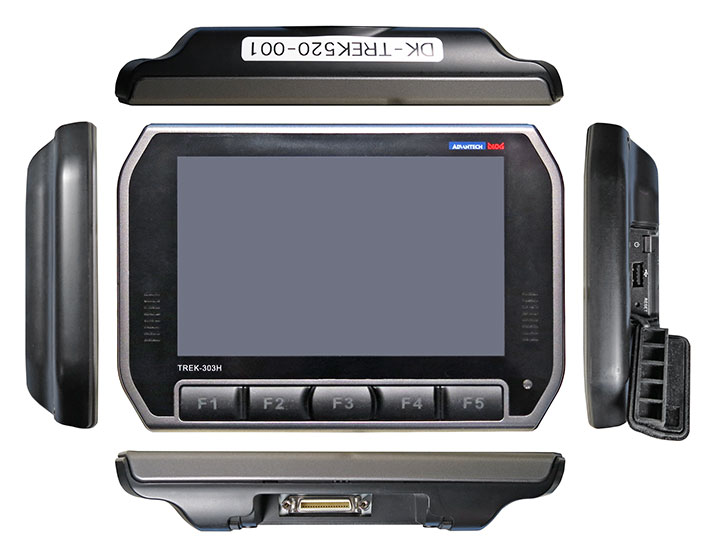
Additional thoughts about TREK-based Mobile Resource Management systems
As an early adopter of GPS technology (mid 1990s) and also having some experience with OBD-II, which stands for "OnBoard Diagnostics," the increasing use of computers in vehicles is no surprise to me, nor is the increasing sophistication and innovation of such uses. In fact, we're probably seeing just the beginning, especially given the emergence of increasingly useful IoT applications.
It is hard to overestimate the potential benefit of mobile resource management. Intelligent fleet monitoring can revolutionize the way a business is run. In addition to basics like theft protection, dispatchers and fleet management know at any time where their vehicles are, what routes they have run, what the odometer reading is, and whether they are being used according to plan and policy.
An advanced system may not only provide vehicle location on a map, geofences, remote alarms and door unlocking, but also detailed history reports that can show hourly usage, violations, speeding, or many other parameters.
All sorts of special sensors can be used to retrieve information from the OBD-II onboard diagnostics system that has been mandatory in vehicles sold in the United States since 1996. OBD-II tracks dozens of vehicle functions, and that data could be used to provide fuel efficiency data, warn of potential vehicle and component failures or manage maintenance requirements. And the industry is just beginning to meld the up to now completely separate world of vehicle computers, generally known as ECUs (Engine Control Units), with computers and communication systems as we know them.
If all this sounds enormously complicated, it is and it's not. Installation of a GPS vehicle tracking system is inherently no more difficult than that of a car audio or navigation system. Setting up web-based tracking reports is simple as well, and can be done both for individual vehicles as well as for small and large fleets.
How much does it cost? That depends on the type and system as well as the software it comes with. Developers and systems integrators may use the rugged Advantech TREK platform to create simple or complex vehicle and fleet management systems. IT departments may build their own applications using Advantech tools and standard Windows development environments. TREK based systems may be deployed as inhouse applications, or sold as turnkey or subscription-based systems.
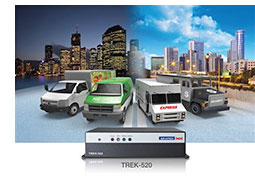 Mobile Resource Management and GPS-based M2M systems are becoming increasingly popular as they easily pay for themselves with the theft protection and peace of mind they provide. They can also generate potentially dramatic savings and increased efficiency in commercial fleet management applications. Mobile Resource Management and GPS-based M2M systems are becoming increasingly popular as they easily pay for themselves with the theft protection and peace of mind they provide. They can also generate potentially dramatic savings and increased efficiency in commercial fleet management applications.
In summary...
With the TREK-520, Advantech offers a tough, economical, compact in-vehicle computer for local fleet management and mobile resource management applications. The system is simple to deploy and use, can interact with vehicles and sensors, and offers superior wireless connectivity with dedicated external antennae to streamline operations, optimize vehicle use, and reduce errors, fuel usage and overall costs.
-- Conrad H. Blickenstorfer, October 2014
Advantech TREK-520 Specs:
| Type |
Compact ruggedized in-vehicle computer
|
| Added |
Added 09/2014
|
| Processor |
Single-core 800MHz Texas Instruments Cortex-A8 AM3703, or single-core 1GHz AM3715
|
| OS |
Windows CE 6.0 R3 core version or Linux v2.6.37
|
| GNSS |
Integrated GlobalSat EB-5662RE module |
| RAM |
512MB or 1GB LPDDR |
| Storage |
1 x internal non-accessible 4GB SD Card that supports system boot, 1 x externally accessible push-push type SD Card slot |
| Display |
Use TREK-303H or similar
|
| Expansion/slots |
1 x externally accessible push-push type SD Card slot, 1 x SIM Card |
| Display interface |
Smart Display Port (combines 18-bit LVDS out (800 x 480), 2 x UART, audio out, 2 x USB 2.0 Type A, 12V power, power and reset signals) |
| Housing |
Steel |
| Size |
6.77 x 5.28 x 1.73 inches (172 x 134 x 44 mm) |
| Weight |
2.0 pounds (990 grams)
|
| Operating temperature |
22° to 158° degrees Fahrenheit (-30° ~ 70° degrees Celsius) |
| Humidity |
unknown |
| Vibration and shock |
MIL-STD-810G, Method 516.5, EN60721-3(5M3) |
| Power |
Supports 12/24V car power systems (6V ~ 32V DC input w/o backup battery, 12V ~ 32V DC input with backup batteryISO 7637-2, SAE J1113), 7.4V 2,000mAH UPS backup battery |
| Interface |
Vehicle I/O port (2 x CAN Bus, 1 x J1708 with J1587 support, 2 x isolated DI, 2 x isolated DO
Standard I/O: 1 x Mini-B client USB, 1 x USB 2.0 Type A, 1 x RS232, 1 x audio in, 1 x stereo out
|
| Wireless |
802.11b/g/n + Bluetooth 2.1 + EDR, WWAN (HSPA+/UMTS, GSM/GPRS/EDGE: Telit HE-910D via mini PCIe slot; CDMA, EV-DO: Telit DE-910 via mini PCIe slot), 3 x external antenna (GPS, WLAN, WWAN) |
| Certifications |
CE (R&TTE), FCC ID |
| Price |
inquire |
| Product brochure |
TREK-520 brochure (PDF)
|
| Product web page |
Advantech Advantech TREK-520 web page |
Advantech Corporation
13 Whatney
Irvine, CA 92618
Toll Free: 1-800-866-6008
Ph: 949-420-2500
Fax: 949-420-2501
ECGInfo@advantech.com
www.advantech.com
Advantech Co. Ltd.
No.1, Alley 20, Lane 26, Rueiguang Road
Neihu District, Taipei Taiwan 114, R.O.C.
Tel: 886-2-2792-7818
Fax: 886-2-2794-7301
www.advantech.com
|








 Note the blocks of thermally conductive material sitting on top of several of the chips. These make contact with the housing cover which serves as a cooling sink.
Note the blocks of thermally conductive material sitting on top of several of the chips. These make contact with the housing cover which serves as a cooling sink.

 Mobile Resource Management and GPS-based M2M systems are becoming increasingly popular as they easily pay for themselves with the theft protection and peace of mind they provide. They can also generate potentially dramatic savings and increased efficiency in commercial fleet management applications.
Mobile Resource Management and GPS-based M2M systems are becoming increasingly popular as they easily pay for themselves with the theft protection and peace of mind they provide. They can also generate potentially dramatic savings and increased efficiency in commercial fleet management applications.